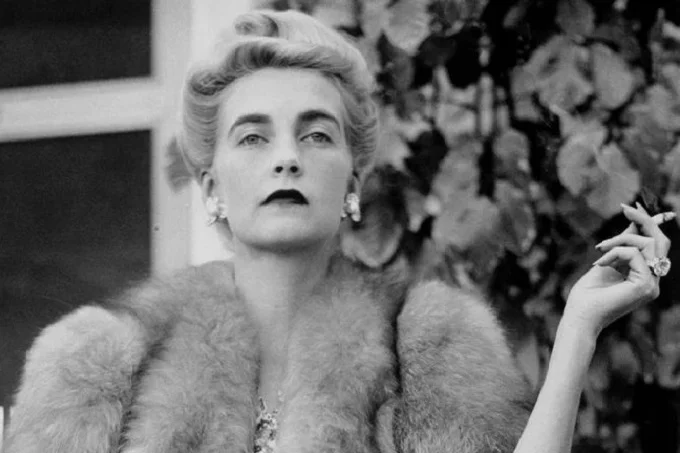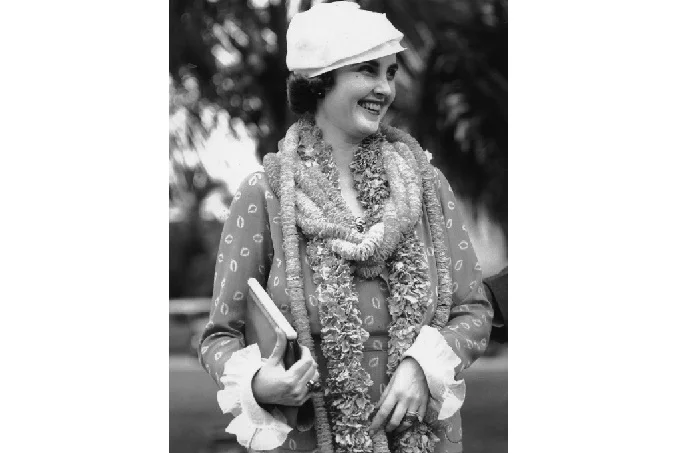Barbara Woolworth Hutton: richest and lonely woman in the world

Barbara Woolworth Hutton is one of the richest and loneliest women in the world: seven toxic marriages, addictions, anorexia and the search for cab boys.
From the age of 12, Barbara Woolworth Hutton was the richest child-woman of the 20th century. When her mother died, her father abandoned her to her fate. The fortune hunters who claimed to love her, the bulimia and anorexia that led her to weigh 40 kilos and the sad years in which she paid young prostitutes to mitigate her loneliness. How her fortune was diluted, and she ended up with only 3 thousand dollars in cash.
She was found dead in her suite at the Beverly Wilshire Hotel, Beverly Hills, Los Angeles, on the morning of May 11, 1979. She was only 66 years old and weighed 40 kilos. Alcohol and drugs demolished her body: she barely ate, and anemia did its work.
The death certificate was terse: myocardial infarction. Her cash, even more so: she had only $3600 left in cash.
She was born Barbara Woolworth Hutton, in New York, on November 14, 1912, into a cradle of gold. Her mother, Edna Woolworth, was one of the three wealthiest heiresses in the country: Helena, Jessie and she, daughters of tycoon Frank Winfield Woolworth, married another potentate: Wall Street broker Franklyn Laws Hutton. Her grandfather Frank was also the owner of the most popular department store chain in the United States: in 1917, he opened his 1,000th store in the heart of Fifth Avenue. An extreme model of the self-made man. The son of an English farming family, in 1900, the hinge between the 19th and 20th centuries, he set out to conquer the American dream, but in the first stage of the adventure he was struck down by a serious illness. His parents hired a nurse, Edna, who not only assisted him day and night: she married him.
In 1915, the family moved into a suite on the fifth floor of the Plaza Hotel in New York, key to her father’s business: as close as possible to Wall Street and Big Money. Barbara was five years old there, and her childhood shielded by millions of dollars was shattered in the worst way: her mother died, and she was the first to see the body. A trauma that marked her by fire.
The death certificate said “Mastoiditis” (infection of the mastoid bone of the skull), but the loud rumor –a perfect oxymoron – spoke of suicide with poison for the grievances of her husband, a legendary womanizer.
There was no autopsy: it is possible that this was decided by a judge, a friend of the widower, after payment of a generous check.
Barbara Woolworth Hutton began a lonely life. Her father did not take care of her, she was left in the hands of her grandparents, but both died three years later. Homeless, Barbara inherited her mother’s fortune: $150 million (a billion today). And at the age of twelve, she became the richest woman-child in the world.
A student at the exclusive The Hewitt School in Lenox Hill, her shyness and emotional instability made her the target of ridicule and the childish cruelty of her classmates. At the age of fourteen, she returns to New York to live with her aunt Jessie: a tenuous step in her favor that mitigates her shyness.
In 1930 she turned 18—presented in society, in the high society style. The party, displayed with the infinite resources of luxury, costs 60 thousand dollars. A fortune at that time. Three years later, in the middle of the Great Depression, a certain press crucified her for the waste of money at that party and the money spent at each of her social gatherings.
Her father, who had left her adrift since she was five years old, sent her to Europe to stop the newspapers’ campaign, warning her: “From now on, every man who approaches you will be to live off your fortune”.
Thus, Barbara begins her third life. She is only 21 years old, and has money for oceans, beauty, but also her depression and falls into bulimia and anorexia. And the gold diggers smell her vulnerability.

The first to approach is Alexis Mdivani, a Russian from Georgia, who fled there with his brothers after the Soviet invasion. A social climber of good looks and good clothes, he was already married to Louise Van Alen, a friend Barbara met on a beach in Rhode Island. Alexis’ sister, Roussie, a great manipulator, managed to get her brother and Barbara married to avoid a scandal: invited to San Sebastian, Alexis had had s3x with her –a premeditated maneuver –, and only a quick wedding would avoid social disrepute. And Barbara fell into the trap.
They were married on June 22, 1933, at the Orthodox Church in Paris, and Barbara’s father gave the groom, as a dowry, a million dollars: barely a shadow of what the climber would spend on a mansion, polo horses, brand-name clothes and men’s jewelry, with checks signed by his wife.
Her suffering began the same wedding night when her brand-new husband told her. “You are too fat”. From then on, she lived obsessed with weight, it drove her to bulimia and anorexia. In her luxurious luggage, she carried boxes with all the pills that could help her in her bitter life: for sleeping, for pain, for not eating, for anguish and depression. The marriage farce ended two years later with the divorce.
Two days after the separation, the second candidate for a husband arrived. It was Count Kurt Haugwitz-Reventlow, with whom Barbara had Lance, her only son. The count dominated her and extracted thousands of dollars from her by force of verbal and physical abuse. One of these brutal punishments forced her into a hospital, and cost him jail time. Among other humiliations, he forced her to renounce her American citizenship and embrace Danish citizenship in order to evade the tax authorities.
Barbara entered a labyrinth with no way out or with the worst of the exits: drugs, and anorexia that tormented her for the rest of her life and destroyed her ability to father more children.
It was obvious: they divorced, and she won custody of their son after an all-out court war. But, repeating what her father had done, she left Lance’s upbringing in the hands of expensive governesses and boarding schools.
In 1938, an aimless Barbara had a sexual escapade with the famous film producer and director – as well as an insatiable aviator and womanizer – Howard Hughes at the Savoy Hotel in London: long evenings in the round bed with satin sheets in Barbara’s suite. But according to her, “violent and frustrating because I couldn’t reach orgaxm, and he couldn’t stand it.”
In 1939, on the edge of the first cannon fire of the Second Great War, Barbara moved to California, supported the French Resistance against Nazism with money, donated her fabulous yacht to the British Navy, and sold war bonds relentlessly.
In those turbulent days, she met the only decent man who passed through her life: the English gentleman Archibald Alexander Leach, the real name of the movie superstar Cary Grant. They were married on July 8, 1942.
The scandal press, which never left Barbara in peace, who was nicknamed “Poor little rich girl”, defined that union as “Cash and Carry”: rogue judgment, since he had a high cachet, loved his wife -though without ever abandoning his gay partner, the actor Randolph Scott-, they divorced without him claiming a dollar, and he worried all his life about her fate: a machine of mistakes, of anguish, of deep loneliness, which he sought to compensate in the worst way—even paying men for companionship.
Barbara left California, settled in Paris, bought a palace in Tangier (the Sidi Hosni), which would be her summer residence from 1948 to 1975, and met Igor Troubetzkoy, a Russian prince with a skinny ruble purse but known as urbi et orbi: a race car driver, he raced the Monaco Grand Prix for the Ferrari team, won the mythical Targa Florio, and in 1948, in Switzerland, he married Barbara. It was less than a marriage: the driver came into good money, demanded a divorce, and she tried to commit suicide.
The wheel of the end sped up: more drugs, more alcohol, more money blunders. Like the brief and onerous relationship with the Dominican diplomat and international playboy Porfirio Rubirosa – whose pen!s, according to Truman Capote, “was as thick as a man’s wrist” – partner of the super sexy Hungarian actress Zsa Zsa Gabor, adopted by Hollywood. Once again, Barbara fell into the trap. She married him, discovered his relationship with the Hungarian, and after 53 days, they divorced. But Porfirio pocketed a monumental payout.
Always in desperate search of a man who really loved her, her next marriage – from 1955 to 1959 – was to her old German friend Gottfried Alexander Maximilian Walter Kurt Freiherr von Cramm. Occupation: top tennis player. Divorce due to boredom. He died in Cairo in 1976: in a car accident. From 1957 to 1960, she was a partner of the American James Douglas Henderson III, son of the U.S. Secretary of the Air Force and attaché in Paris. Three years of romance that, this time, did not end at the altar.
In 1960, on the immediate echo of her goodbye to Henderson III, she met the young, wandering, adventurous guitarist – 23 years old and she 48 – named Frank Franklyn. For more romantic sophistication, she met him in a bar in exotic Tangier. She took him to her world (antipode of Morocco, by the way), showered him with lavish gifts, was his lover morning, noon and night, and even renamed him with an allegedly aristocratic pseudonym: Lloyd Franklyn, no less. But the guitarist doubled the business: he left her and soon married the Englishwoman Penny Ansley, heiress to a fortune in pounds.
His seventh and last marriage, in 1964, fell on a nobleman or supposed nobleman: Pierre Raymond Doan Vinh na Champassak, millionaire (of course, in ruin), owner of some properties in Indochina. All very vague and very far away. They divorced two years later.
Years of fleeting romances followed, parties in honor of the New York jet set that, besides costing fortunes, ended with expensive gifts for everyone.
As if money was burning her, she gave away – compulsively – jewels, cars and even houses to almost strangers, while the long list of the staff of her summer mansions weighed more and more on a fortune that was beginning to falter. Not to mention the fortune she was spending on her addictions.
In 1972, the collapse was imminent. In Spain, a brief affair with the bullfighter Angel Teruel, and as a coup de grâce, drama: Lance, her son, dies in a plane crash.
Depression closes its grip on the poor rich girl, who tries in vain to escape with more alcohol, drugs and barbiturates. Confined to the Beverly Hills hotel, she even pays cab boys: any false paradise against the tragedy of loneliness.
On the day of her death, the richest woman of the twentieth century had only three thousand dollars. And she could not even fulfill her last wish: to be buried in Tangier. She lies in the Woolworth mausoleum, Woodlawn Cemetery, Bronx, New York. Last echo: in 2019 and at Sotheby’s, the jade bead necklace, signed by Cartier, that her father gave her on the day of her first wedding to a fortune hunter, was sold for $27 million.




